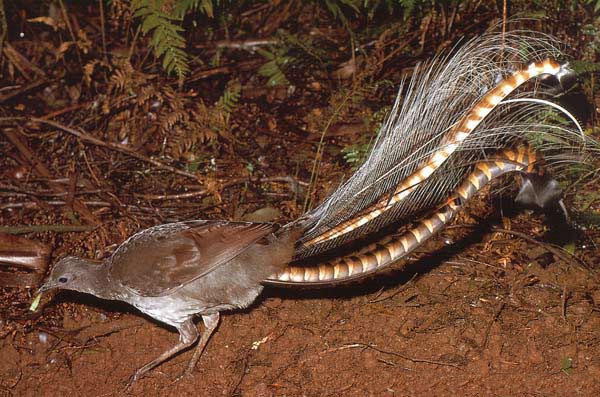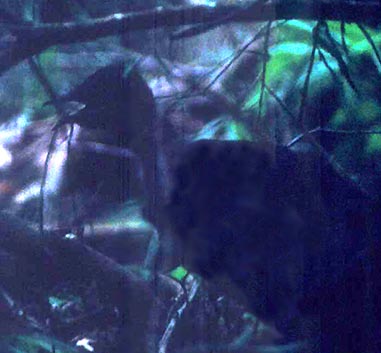 The Lyrebirds are a small Australian family composed of just two species:
the Superb Lyrebird (left and below in superb photos
by
Hans & Judy Beste) and Albert's Lyrebird Menura alberti.
The name "lyrebird" comes from the resembles of the male's tail in Superb
Lyrebird to a Greek lyre (a musical instrument), especially when the male
is in full display (below). The tail has 16 feathers: two lyrates, two
medians, and 12 filaments which are thrown forward over the head in a shimmering
fan during the courtship display (Hans & Judy Beste photo below;
tail details from Simpson & Day 1996). When not in display (left or
above) the male's tail is held about behind the otherwise rather galinaceous-like
bird. The female lacks the elaborate tail feathers; instead, she carries
a longish dingy-brown tail, matching the body plumage.
The Lyrebirds are a small Australian family composed of just two species:
the Superb Lyrebird (left and below in superb photos
by
Hans & Judy Beste) and Albert's Lyrebird Menura alberti.
The name "lyrebird" comes from the resembles of the male's tail in Superb
Lyrebird to a Greek lyre (a musical instrument), especially when the male
is in full display (below). The tail has 16 feathers: two lyrates, two
medians, and 12 filaments which are thrown forward over the head in a shimmering
fan during the courtship display (Hans & Judy Beste photo below;
tail details from Simpson & Day 1996). When not in display (left or
above) the male's tail is held about behind the otherwise rather galinaceous-like
bird. The female lacks the elaborate tail feathers; instead, she carries
a longish dingy-brown tail, matching the body plumage. |

The courtship display of Superb Lyrebird takes place on the ground (right). Albert's Lyrebird displays from vines or twiggy platforms. Albert's lacks the lyrate outer rectrices and has only 14 tail feathers. In both species, males are polygamous and display to as many females as they can; females may visit several males before lying eggs in a bulky, side-entranced nest chamber. For both species, nesting takes place in the Australian winter (Frith et al. 1979, Blakers et al. 1984, Simpson & Day 1996). Albert's Lyrebird is a montane rainforest species limited to a very small area of southern Queensland and northern New South Wales along the Great Dividing Range. Superb Lyrebird has a broader range of elevations — from foothills to sea-level — in rainforests from southern Queensland south to southwestern Victoria. It becomes more common in the southern parts of its range (Blakers et al. 1984). Both species feed to the ground by raking the forest floor with strong feet and claws, searching for insects, grubs, earthworms, and snails. Both species require rainforest with abundant understory vegetation, and both are subject to disturbance and predation from non-native dogs and feral cats. Like many special birds, protecting both them and their habitat is crucial. Lyrebirds are an ancient Australian family with few close relatives. Biochemically, the closest relatives appear to be the Scrub-birds [Atrichornithidae] and, maybe, the Bowerbirds [Ptilinorhynchidae] (Sibley & Ahlquist 1990, Sibley 1974). The bubbling, mimicking, complex songs (see below) might recall Scrub-birds but otherwise nothing much in the passerines resembles them at all. Its a chacalaca-sized songbird with a tail like a bird-of-paradise that sings like a thrasher! |

The song of both lyrebirds is impressive, but Superb Lyrebird is generally considered the more accomplished songster. It has species specific vocalizations, but much of the song is composed of mimic phrases of other birds and natural sounds, including flight calls of parrots and wing beats of large species. The male Superb Lyrebird (right) is hiding in the shadows, gape aquiver, and pouring out the complex phrases, not unlike some North American mimics (e.g., Northern Mockingbird Mimus polyglottos). I suppose that observers who live in Australia have become accustomed to lyrebirds. For those of us visiting on comparatively short trips, finding a lyrebird is a significant goal. We found both species on my first Australian visit in 1983, but not without a good deal of tension. The first was Albert's Lyrebird in Lamington Nat'l Park, s. Queensland; there, short forays into the dense rainforest on well maintained trails from O'Reilly's yielded a male rather quickly our first full morning there. Superb Lyrebird, though, proved elusive at several spots. Our final chance was at a place called Sherbrooke Forest, east of Melbourne. We had arrived the night before after dark and took lodging in a cold, foreboding fortress-like hotel that seemed to be set in Transylvania. We had only a few hours the next morning to conduct our final search, and Sherbrooke Forest proved to be in a park in rather populated area. It was filled with joggers and walkers and noisy packs of kids. We three young American birders walked numerous trails — seemingly for miles — and came up empty. Just as time was running out, one of us happened to mention to a jogger that we were looking for lyrebirds. "Oh," she said, "there was one on the path I've just run a few minutes ago." And so we were off jogging ourselves! With good fortune, the female was still quietly feeding along the path but, had we been a few minutes late, she would have disappeared into the thick undergrowth. Since then, return trips to Australia have located lyrebirds more readily, but I still recall the rush of adrenaline when we heard the news that our first Superb was just a short jog away! |
|
Photos: The Superb Lyrebird Menura novaehollandiae shown in the top two photos was a displaying male, photographed by Hans & Judy Beste in the Dandenong Ranges, Victoria, Australia, in 1977. The silhouetted singing male was in the shadows of Badger Weir Park, Victoria, in January 1998. Photo © 2003 D. Roberson (bottom) and © 2003 Hans & Judy Beste (top two) and used with permission; all rights reserved. Hans & Judy Beste are available to guide independent birders, small groups of birders and wildlife photographers in search of particular species during a visit to Australia, for a reasonable fee; just email them at the link. Bibliographic note There is no family book as yet, and the Handbook of the Birds of the World has not yet reached this group, but the Australian literature that includes this family is reasonably extensive. Literature cited: Blakers, M., S.J.J.F. Davies, and P.N. Reilly. 1984. The Atlas of Australian Birds. Royal Australian Ornith. Union, Melbourne Univ. Press, Carlton, Victoria.TOP |